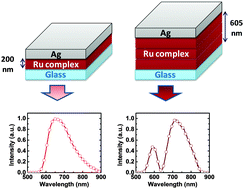Host-only solid-state near-infrared light-emitting electrochemical cells based on interferometric spectral tailoring
Abstract
Solid-state near-infrared (NIR) light-emitting electrochemical cells (LECs) possess great potential in applications of NIR light sources due to their simple device structure, compatibility with large area and flexible substrates and low operating voltage. However, common host–guest NIR LECs suffer from the problem of significantly enhanced residual host emission upon increasing the bias voltage to achieve a higher NIR light output. A higher NIR light output can only be obtained at the expense of spectral purity in host–guest NIR LECs. To enhance the NIR light output of LECs without sacrificing the spectral purity significantly, a novel approach to generate NIR EL from host-only red-emitting LECs by adjusting the device thickness to modify the microcavity effect is proposed. NIR EL from host-only red-emitting LECs can be realized by adjusting the device thickness to shift the peak wavelength for constructive interference at the NIR spectral region. NIR EL resulting from the microcavity effect is relatively insensitive to bias voltage. Therefore, without losing spectral purity significantly, a 20× enhancement in the NIR output has been obtained in comparison to the previously reported value from host–guest NIR LECs. These results reveal that tailoring the EL spectra of host-only red-emitting LECs via modifying the microcavity effect would be a promising way to generate a higher NIR light output without suffering from the residual host emission problem of host–guest NIR LECs.


 Please wait while we load your content...
Please wait while we load your content...